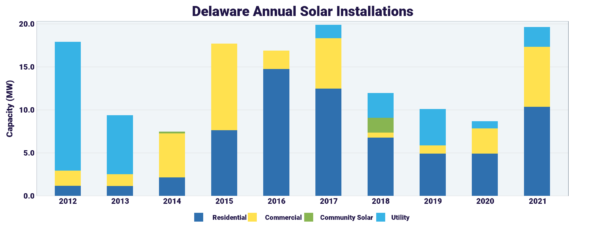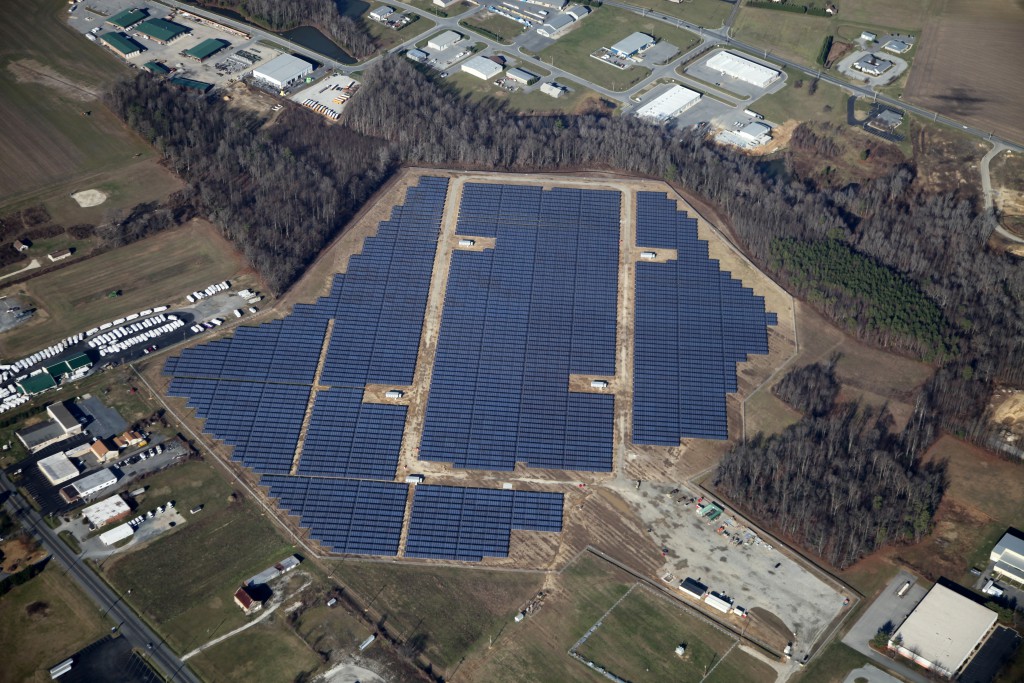The pv magazine USA tour of solar incentives now takes us to the South-Atlantic region, with the first stop in Delaware, the second smallest state in the nation. While it is the sixth least populated state, it is also the sixth most densely populated state. Delaware is home to the Institute of Energy Conversion at the University of Delaware, founded in 1972 and believed to be the oldest continuously operating solar research institute in the world.
Delaware is currently ranked 41st in solar installations in the country, according to the Solar Energy Industries Association. That’s down from 37th in 2021. Less than 5% of the state’s electricity is derived from solar, and SEIA’s growth projection is for only 341 MW installed in the next five years, dropping the state further to 44th.

Last year the Governor signed a bill boosting the state’s renewable portfolio standard to 40% by 2035, with 10% required to come from solar. When the bill passed, the Sierra Club welcomed the increased RPS, but the group argued the new 40% target was too low and left Delaware “behind virtually every state in the region,” most of which have targets 50% or higher.
To meet the new RPS, two Delaware utilities are offering incentives for customers to add solar. Delmarva Power offers a cash rebate of $0.70 per watt of solar generating capacity installed up to 50 kW, to a maximum of $6,000. Delaware Electric Cooperative offers customers $0.50/W of solar power installed (up to 5 kW), and $0.20/W for any additional solar capacity.
Net metering
The state currently has some strong solar incentives in place, in addition to the federal investment tax credit of 26% for the cost of equipment installed. Delaware’s net metering law allows third-party solar financing and offers a full retail rate for net metered electricity, meaning that homeowners receive the same rate for their excess solar-generated electricity that homeowners pay the utility for grid-supplied power.
Community solar
Community solar has been approved in Delaware since 2010, but a bill signed into law in September 2021, expands access to community solar projects. SB 2 increases the maximum size of systems to 4 MW, requires that each system owner to certify that at least 15% of its customers are low-income, eliminates the requirement that all customers be on the same distribution feeder, and more.
Low- to moderate-income programs
In addition to the requirement for low-income customers to have access to community solar, the Delaware Department of Natural Resources and Environmental Control (DNREC) recently announced the launch of a two-year pilot program for low- to moderate-income households, offering free solar panels or cost assistance, depending on eligibility. Low-income households must first apply for installation services through the DNREC’s Weatherization Assistance Program, a cost-free program that improves residential energy efficiency through weatherproofing and other home improvements. Homes that qualify can receive a free solar installation of up to 4.0 kW. Moderate-income households can receive a solar installation 70% covered by the assistance program, and 30% is paid by the homeowner, for systems up to 6.0 kW in capacity.
A complete list of solar incentives available to Delaware residents can be found here.
Notable installations
Delaware’s largest solar installation is the 15 MW Milford Solar Farm. Commissioned in 2012, it generates 21,000 MWh of electricity or enough to power 9,000 households, offsetting 12,000 tons of carbon dioxide emissions (CO2) a year. The project is owned by PSEG Solar Source and the electricity is sold to Delaware Municipal Electric under a 20-year power purchase agreement. The project includes 30 ABB inverters and 62,000 Canadian Solar modules on fixed-tilt racking systems. Juwi solar is the contractor and provides EPC services.
The longstanding Milford project is about to be eclipsed by two much larger installations: the 114 MW Cedar Creek Solar Project in Townsend and the 50 MW Raceway Solar Project in Harrington. Both are currently under construction by Freepoint Solar.
Last time, the pv magazine tour of the 50 states of solar took us to neighboring New York, and next we will continue to travel through the South-Atlantic region.
This content is protected by copyright and may not be reused. If you want to cooperate with us and would like to reuse some of our content, please contact: editors@pv-magazine.com.









To promote rooftop solar we should Standardize Net Metering Nationwide to be an Energy Credit in kWh and not a monetary rate credit. That’s the best reward for solar NEM customers who invested their own funds since 2005 to promote solar and help reduce carbon emissions by offsetting their and some of their neighbor’s daytime usage from fossile fuels.
Energy credits assures monthly bills are strictly based on the NEM customer’s NET kWh usage, thereby reducing the amount of kWh customers are charged at lowest tiered rates.
Energy credits also avoids Utility Fees and Taxes on Excess Solar kWh, since they’ve already been paid by those who received the excess solar kWh as it was being generated during the day, ie: by neighbors closest to NEM customers by Path of Least Resistance.
https://www.nrel.gov/state-local-tribal/basics-net-metering.html
This would prevent utilities and local governments toying with rates and billing schemes in response to anti-NEM solar activists who despite years of incentive FETCs have declined putting their money where their mouth is.
If Qualified Low Income customers want “solar benefits”, utilies–as many have–can simply offer lower rates instead of installing more costly and less efficient rooftop systems than utility scale solar farms they should be investing in to offset some fossile fuel generation.
Rooftop systems aren’t suitable for multi-story housing units (apartments, condos, etc.) where roof area per resident is insufficient to benefit each significantly. It avoids dealing with inequities of roof suitability: type, shade, angle, age & condition and Rules & Regs.
Rooftop solar should not become another layer of our many welfare programs because it sounds good or green because it is NOT as cost effective as utility scale solar.
Multi-story roofs might serve as owned or leased platforms for utility installations serving master metered customers in densly populated cities, provided installation and maintenance costs of roofs and panels are break-even/payback justifiable compared to ground mounted solar farms.
Eco-maniac solar-NEM schemes should be avoided as they tend to stir the pot of utility haters and political backers creating short-sighted, misinformed legislation in return.
Utilities should be able to adjust their monthly “Customer Charges” to fairly defray the fixed costs of installation, maintenance and replacement of generating, transmission and distribution assets, just as is done for other utilities like water, sewer, natural gas, cable, etc.
Otherwise, variable usage dependent costs of energy should be priced by tiers aimed at conserving use by all customers, rich or poor.